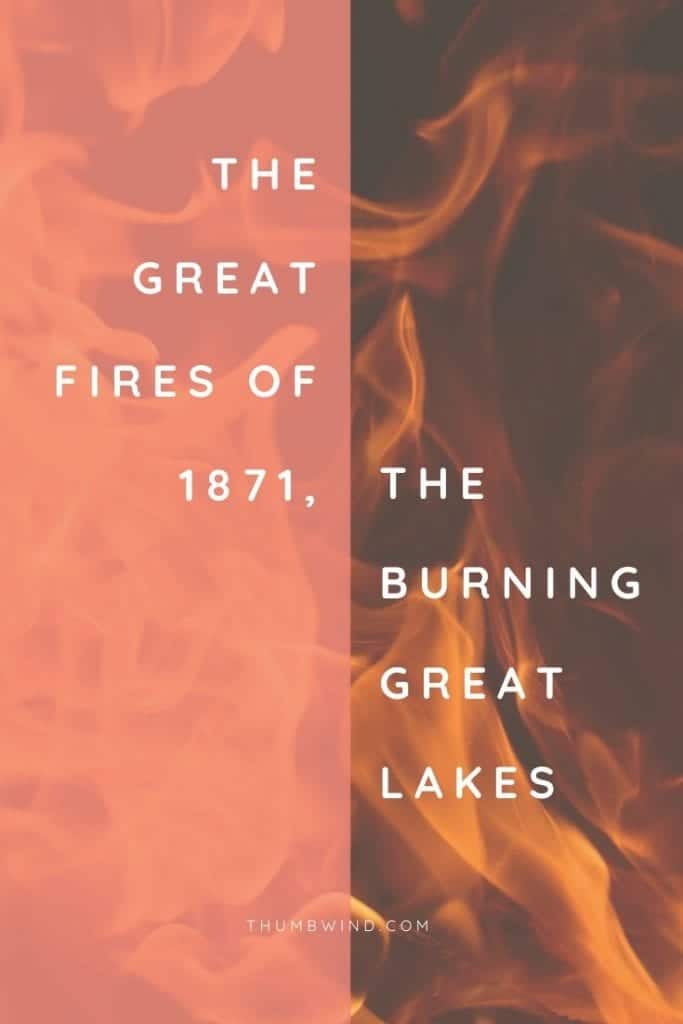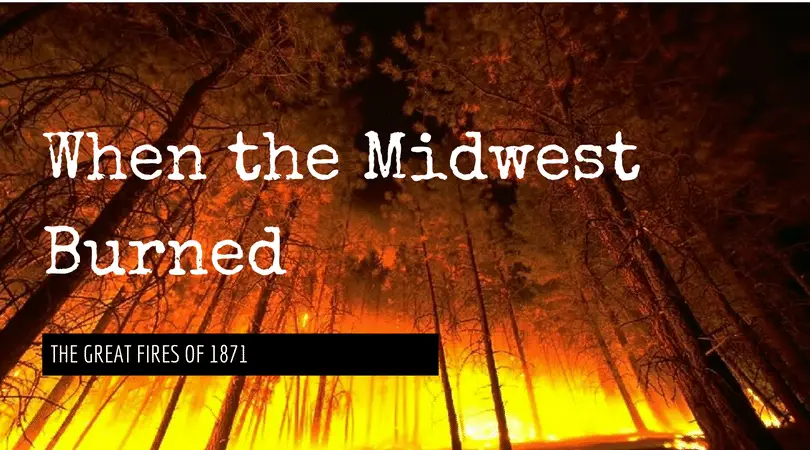The summer of 1871 was dreadfully hot and dry in Michigan’s Thumb. Farmers watched their crops wither in the dry heat. In the fall, relief from the drought was no better. Folks began to worry that there were to be some lean winter months ahead. The heat and the lack of rain did not only affect eastern Michigan. The conditions stretched west into Wisconsin and northern Illinois. The whole region was a tinderbox for the great fire of 1871. Michigan and the rest of the region were amid a lumber era. Lumberjacks and woodsmen from Maine used a slash-and-grab method of timber harvesting. The endless piles of branches, stumps, and pine debris from the once numerous white and cork pine dried in the heat all summer long.
What We Will Cover
Mysterious Start of Fires Across the Great Lakes

It was Sunday, October 8, that fires near Peshtigo, Wisconsin, and Chicago came to life. No one is certain how they started. The Chicago fire’s popular lore tells that a cow, owned by Mrs. O’Leary, purportedly knocked over a lantern in her barn that set off the blaze. While in Wisconsin, a sudden fire mysteriously starts outside of Peshtigo. A few hours later, across Lake Michigan, fires erupt in Holland and Manistee. Later in the day, the fire rips across Michigan only to be stopped by Lake Huron’s shores north of Port Huron at the lake’s southern end. Historians and meteorologists point to a cyclone-like system of winds parked over the eastern plains in early October that fanned and fueled the fires.
1871 Chicago Fire was Famous but the Peshtigo Fire was Horrific
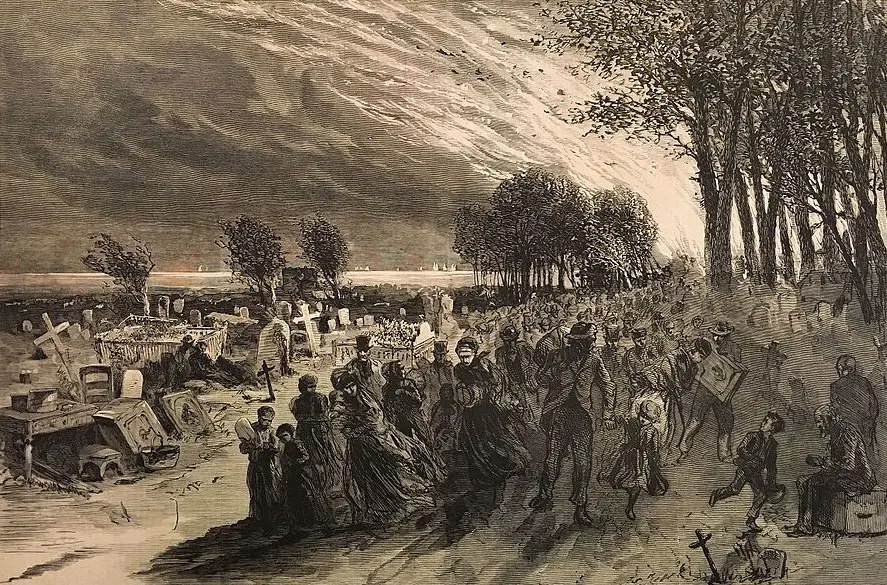
The fire in Chicago burns about three square miles of the city, consuming more than 17,000 buildings and 300 lives.
The fire reached Peshtigo, Wisconsin Sunday evening, October 8th. Residents flee. Some survivors jumped into rivers to escape the flames and witness firestorms or “tornadoes of fire,” which devastated enormous areas. Some who went into the Peshtigo River during the fire boiled alive in the 2000 degree firestorm.

By the time the fire ended, it had consumed 1.5 million acres and an estimated 1,200-2,400 lives, including approximately 800 in Peshtigo. Only one building in Peshtigo survived the fire. Pleas for assistance from the area go unheeded as there was no telegraph service. The Peshtigo fire goes down in history as the worst fire disaster in the US of all time.
Map of the Great Fires of October 8, 1871
Historians have grouped these 37 individual fire areas into five major fires that burned in the Great Lakes region; the Great Chicago Fire, the Great Peshtigo Fire, the Port Huron Fire, Holland Fire, and the Manistee Fire. Collectively all the towns burned down in Michigan are called the Great Michigan Fire of 1871
Fires First Appear in Michigan October 8th 1871
That same Sunday across Lake Michigan, residents of the shoreside town of Holland gather to fight small fires that suddenly were to flare up on the southern part of the town. By late afternoon, winds increased to hurricane strength. As night sets in, there was no hope of saving the town as buildings on the town’s western edge caught fire. “The entire territory covered by the fire was mowed as clean as with a reaper; there was not a fence post or a sidewalk plank, and hardly the stump of a shade tree left to designate the old lines,” said one resident. The landscape of several West Michigan towns was forever altered. The fire at Holland Michigan destroyed 76 businesses, 243 homes, 5 churches, 3 hotels, 5 warehouses, and 45 other buildings. A total loss of $900,000.
Fire Moves into the Michigan Thumb Area
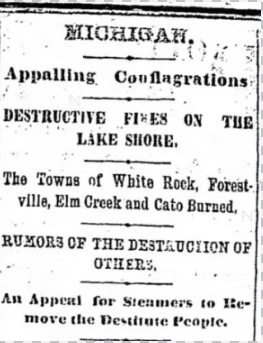
In Michigan’s Thumb, the situation could not be worse. The prevailing winds brought embers and dense smoke from the other Michigan fires burning in the west. In just over 30 hours, the forest fires that started in Manistee marched through Grayling and Big Rapids. Following the slash-loaded timbering trail, it swept through Isabelle, Midland, and Bay counties and halted in Gratiot County, where there had been no lumbering. The respite was to be short-lived. Burning embers ignited small piles of slashings along the Cass river until it reaches Caro. Once there, piles of dry logging brush allowed it to blast across and up the Thumb.
Blinded by smoke and pushed the rushing 100-foot flames, residents jumped into wells or rushed to the lakeshore, where they saved themselves by wading into the water. One small boat held nine children from Rock Falls and drifted for three days across Lake Huron to Canada. All but one child survived the ordeal.
Michigan Towns Try to Fight the 1871 Fires
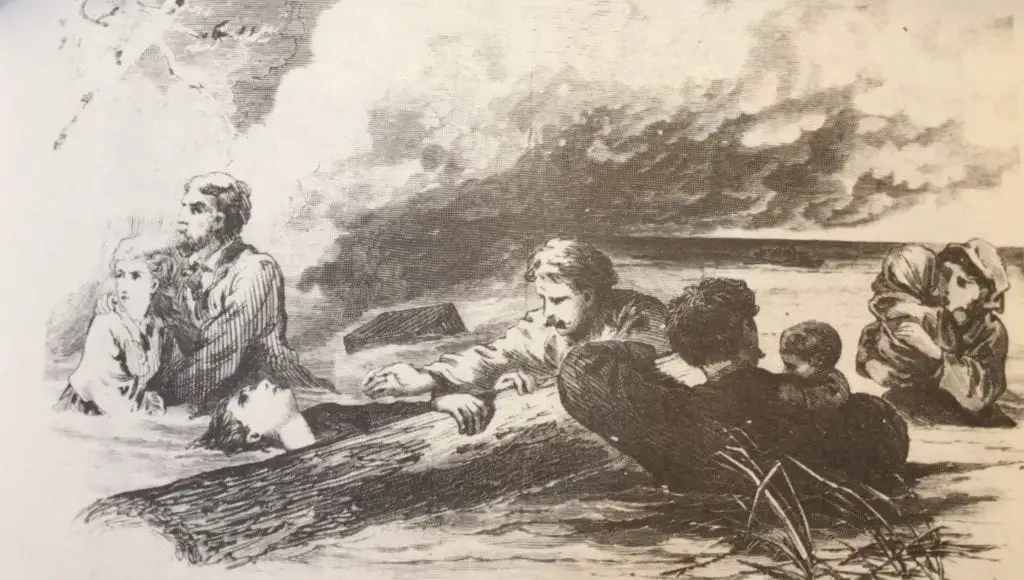
Like in the other close communities of Michigan, the entire town of White Rock fought the fire all day Sunday, but when the hurricane winds fed the fire, it went out of control. The town folk took to the lake and remained for the rest of the day in the cold, battered by waves caused by the vortex. When the fire died down, they dried themselves from the embers of the fire until the steamer Comet rescued them.
The eastern Thumb town of Huron City, with engulfed by flames. The small-town residents tried to fight the flames but soon fled to Lake Huron to save themselves.
By the evening of Tuesday, October 10, all the fires across the Midwest begin to end. Rain moved into the area and damped down the fires into a smoking monster that lasted for days. Michigan’s Thumb area was devastated. Most of Huron, Tuscola, and Sanilac Counties went up in flames, and residents took to the shore looking for rescue.
Fire Survivors Trek to the Tip of Michigan’s Thumb
In the days after the fire, accounts trickle in that survivors make their way to Port Austin. Houses are filled with residents from Port Hope and Grindstone City. Victims walk into town with singed or missing hair, blistered faces, and clothes practically burned off their backs. An announcement was made in Detroit that any donations made on the Griswold dock in Detroit will find their way to Port Austin.
Michigan Responds to the Great Fire of 1871
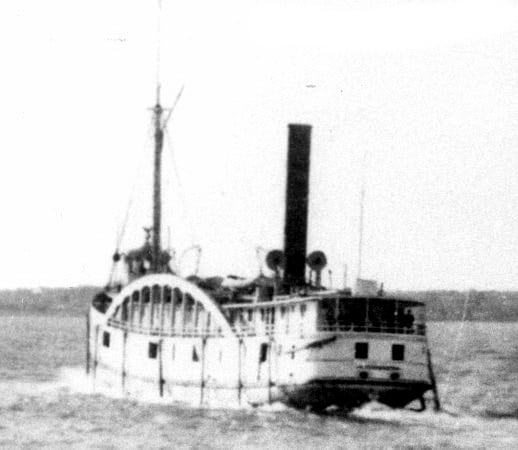
The Thumb communities of Glen Haven, White Rock, Forestville, Sand Beach, Port Hope, Grindstone City, Elm Creek, Huron City, Forest Bay, Center Harbor, Rock Falls, Verona Mills were almost totally obliterated, and the residents were left destitute, without food, shelter and with only the clothes on their backs. Winter was only weeks away.
In the days that followed a relief and recovery, the effort was headquartered at Port Huron. A plea for ships was sent across the Great Lakes. The Wisconsin steamer Comet, cruising from Lexington to Pointe Aux Barques, reported seeing continuous flames up the entire coast. The smoke from shore was so intense that it drove passengers back into their cabins. Burning embers were hitting the steamship so much that the decks had to be washed down frequently.
Ships bringing refugees back from the upper thumb reported that the smoke was so thick out on Lake Huron they had to light their lamps to avoid a collision.
The Toll Great Fire of 1871 is Enormous
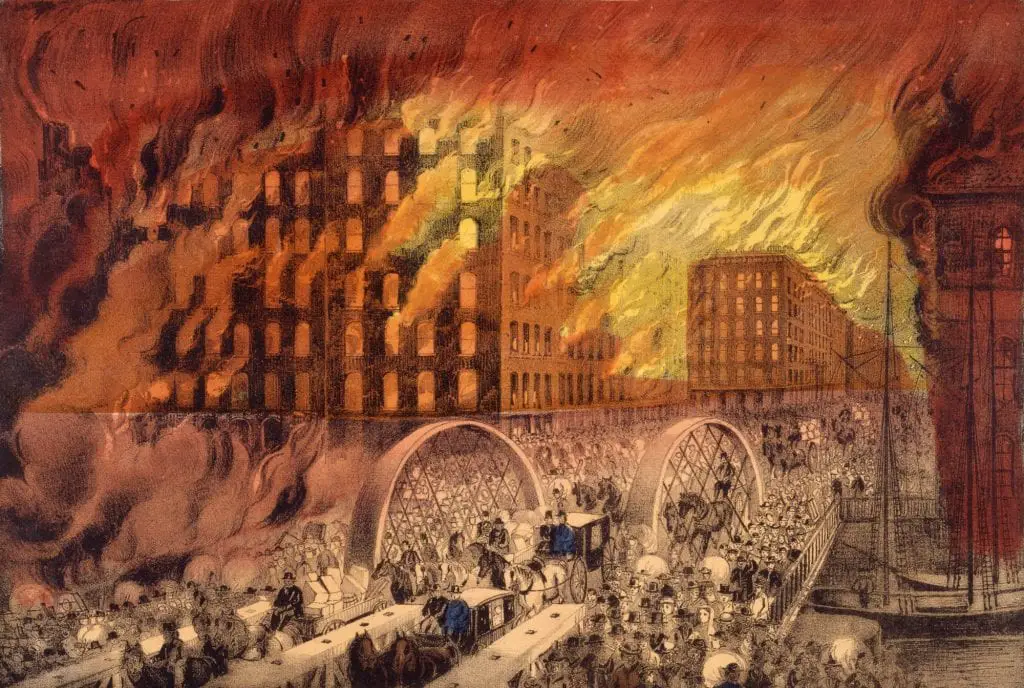
While Michigan’s official death toll numbered at least 10, there were likely many more. In 1871, hundreds to thousands of lumberjacks, labor, and peddling salespeople spread out across the state, along with thinly populated settlements in the remote area across Michigan, making it impossible to ensure an accurate number of lives taken. Ultimately, the fire raged across the upper Midwest over an estimated 2 1/4 million acres of land and destroyed at least 4 billion feet of prime timber. It took almost 2,500 lives, including approximately 800 in Peshtigo alone.
For weeks after the fires, newspapers tracked accounts of relief committees set up at Port Huron, Manistee, and Holland. In some cases, residents returned to the area to start rebuilding. Small homes were built for shelter during the winter months. Lumber companies offered men pay rates up to $35 per month during the winter to go into the burned-out areas and harvest the available timber. Sand Beach was burned out. Merchants in nearby towns such as Packs, Jenks, and Co in Rock Falls purchased any store goods that managed to be salvaged. It was feared that Sand Beach would be abandoned.
Comet Theory Emerges After the 1871 Fires
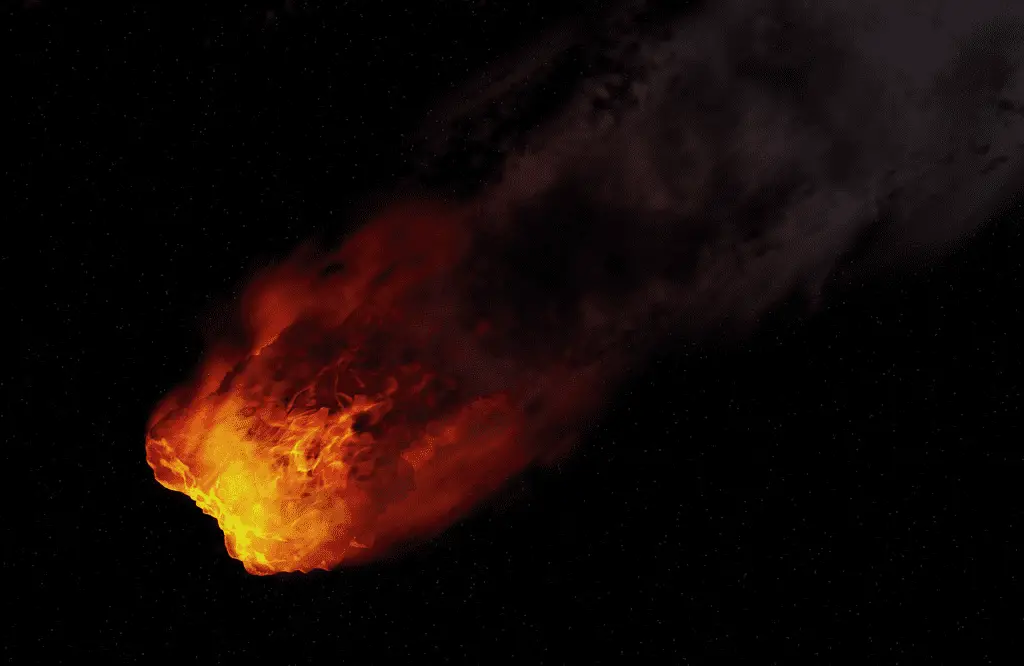
Shortly after the 1871 Great Fire, Minnesota Congressman Ignatius Donnelly wrote a book called “Ragnarok.” The book suggested that Biela’s Comet started the fires. The comet was first discovered in 1821 and had a six-year orbit cycle with the earth. Biela’s comet likely broke upon its approach toward earth in 1872, as it was never seen again. Another hypothesis is that the near-simultaneous fires across the upper Midwest could have resulted from an autumn meteor shower. This theory persists to this day.
Future Impact of the 1871 Great Fires.

The massive fires of October 1871 called into question how to practice good land-use practices. The clear-cut slash methods that contributed greatly to fuel the fire would take years to change. In 1944 a new figure appeared in popular culture that forever changed the public perception of wildfire prevention—the introduction of Smokey the Bear.
Related names for the Great Fires of 1871
The weather and drought conditions in the Great Lakes region in early October 1871 were severe enough to become a major conflagration that spanned hundreds of miles. The fire events are primarily dominated by the effect of the Great Chicago Fire however here are the other names and locations involved.
- The Great Michigan Fire, Michigan Thumb Fire and Port Huron Fire of 1871, – These names are all-encompassing a series of fires that burned twelve towns in Michigan’s Thumb including White Rock and Port Huron, and much of the countryside. The loss of standing timber on the burned-out 1.2 million acres hastened the decline of the lumbering era and gave rise to the agricultural development.The precise death toll from the Michigan fires is unknown, but it is likely to be in the hundreds.
- Peshtigo Fire of 1871 – The deadliest forest fire in American history ripped through northeast Wisconsin, killing over 1200 people. Although the fire burnt 1.2 to 1.5 million acres, it skipped across Green Bay’s waters to destroy areas of Door and Kewaunee counties. The damage was estimated to be $169 million, roughly the same as the Chicago Fire.
- Holland Michigan Fire of 1871 – Around the same time as the Chicago fire, a fire broke out in a forested region southwest of Holland. The ringing of church bells throughout the city notified Holland’s population of about 3,000 of the approaching fire. As a result, almost two-thirds of the town burnt on October 8, 1871. Two hundred residences were destroyed, and one person was killed in the fire.
- The Great Chicago Fire – The most famous fire occurred in Chicago, killing over 300 people and damaging almost three square miles of the city, including more than 17,000 buildings.
MLA Citation Of this Article
Hardy, Michael, et al. “The Great Fire of 1871 • Thumbwind.” Thumbwind, Thumbwind Publications, 29 Oct. 2021, https://thumbwind.com/2021/10/06/great-lakes-fire-1871/.
Related Stories of the Great Chicago and Michigan Fires
- The Thumb Fire of 1881 – 140 years ago, a devastating fire overtook much of the Thumb over several days. Here is a synopsis of the days of that horrific event and its aftermath.
- The 1881 Fire’s Destruction of Parisville and The Four Miracles – The Great Michigan Fire of 1881 devastated one town above all others; Parisville. Parisville, Michigan, was founded by Polish immigrants escaping the Prussian Empire’s oppression; this community claims to be the first Polish settlement in North America. They came from the Boronόw and Śliwice provinces in Poland, temporarily working and traveling in Canada before settling in Michigan’s Thumb’s rich farmland.
- The Famous Garfield Inn – The Inn’s beginnings started as an outcome from the lumber industry’s profits. The description from an 1884 bio of Learned noted, “The village property of Charles Learned at Port Austin includes an elegant residence with grounds attached, containing three acres and worth $12,000.
- Luxury Great Lakes Ship Travel in the 1800s – In the days before the highway and autos, the only way to travel the vast distances for the Great Lakes was by sail and steamer. In the mid-1800s until well into the 1950s, one could travel most of the lakes in style and comfort.
Sources Consulted For Fire of 1871
- http://geo.msu.edu/extra/geogmich/fires.html
- Detroit Free Press October 17th, 18th 1871
- https://www.imagesofmichigan.com/michigan-forest-fire-of-1871
- https://www.wexfordcountyhistory.org/history/
- http://newspapers.rawson.lib.mi.us/chronicle/CCC_1958%20(E)/issues/02-06-1958.pdf
- Milford Times, 18 November 1871
- https://www.newspapers.com/US/Michigan/Alpena/Alpena%20Argus_4101
- http://nla.gov.au/nla.news-title13 – The The Argus (Melbourne, Vic. 11 Dec 1871)
